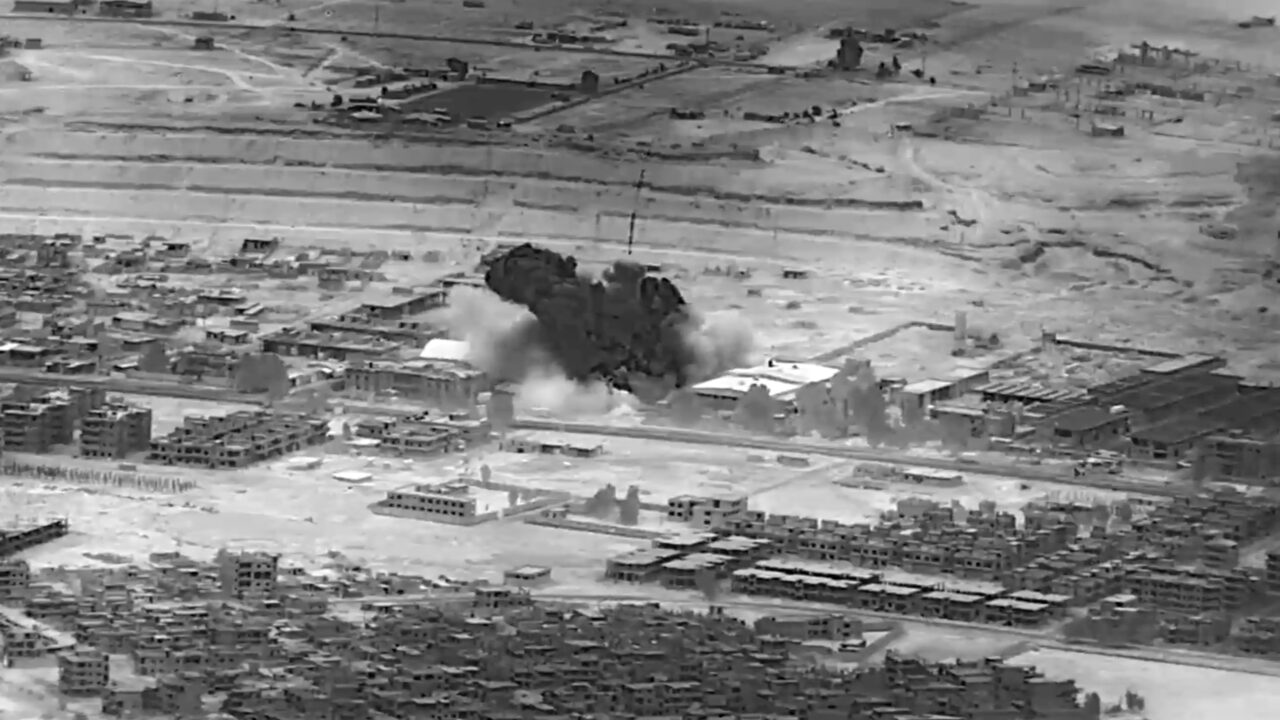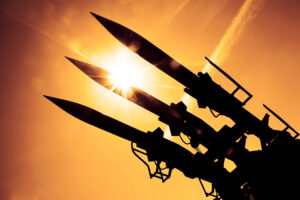Are We Approaching a Point of No Return on Middle East Escalation?
New U.S. strikes killed fighters while the DoD admits 52 attacks against its troops since October 7. This image from video provided by the Department of Defense shows a Nov. 8, 2023, airstrike on a weapons warehouse center, in eastern Syria. According to the DOD, the strike targeted a facility linked to Iranian-backed militias. (Department of Defense via AP)
This image from video provided by the Department of Defense shows a Nov. 8, 2023, airstrike on a weapons warehouse center, in eastern Syria. According to the DOD, the strike targeted a facility linked to Iranian-backed militias. (Department of Defense via AP)
U.S. forces launched a third strike against Iran-linked groups on Sunday, the latest in an increasingly destructive series of exchanges that have cast a new light on the continued U.S. troop presence in the Middle East.
American aircraft struck a weapons storage facility and command-and-control center used by Iran-backed groups in Syria, according to officials. “Within the last two hours, the U.S. has taken precision defensive strikes against two sites in Syria,” an official told ABC News. The two structures were located near the eastern Syrian cities of Mayadin and Abu Kamal, according to statements issued on Sunday by the Department of Defense and U.S. Central Command (CENTOM).
“The President has no higher priority than the safety of U.S. personnel, and he directed today’s action to make clear that the United States will defend itself, its personnel, and its interests,” Defense Secretary Lloyd Austin said in a statement. Up to seven “Iranian proxy fighters” were killed at one of the two locations struck by U.S. warplanes, according to Jennifer Griffin, chief national security correspondent for Fox News, citing a senior defense official.
Attacks on American troops have not only continued but intensified in recent weeks, with Iran-backed militants reportedly assaulting U.S. bases with drones carrying even larger payloads.
This is the third such strike since October 26, reflecting a continued effort by the U.S. to retaliate against Iran-linked groups that the White House says are responsible for a spate of ongoing rocket and drone attacks against U.S. military personnel in Iraq and Syria.
The U.S. sent forces including two carrier strike groups headlined by the USS Gerald R. Ford Carrier and USS Dwight D. Eisenhower, squadrons consisting of F-15E Strike Eagle aircraft and A-10 close-air-support (CAS), and the USS Bataan Amphibious Ready Group to the region following the October 7 Hamas attacks on Israel and subsequent outbreak of war in Gaza. High-ranking officers including a Marine three-star general were reportedly sent to help advise Israeli leadership as it proceeds with its campaign and another 2,000 U.S. personnel were ordered to prepare to deploy last month.
Iranian leaders have unsurprisingly taken a strong policy stance in favor of Hamas, though the full extent of their foreknowledge of and support for the October 7 attack remains unclear. Reports citing U.S. intelligence findings suggest that senior Iranian officials were surprised by the attack, undermining or at least heavily complicating claims of direct Iranian involvement. Nevertheless, Tehran has been accused of mobilizing its robust network of regional proxies to launch scores of attacks against American personnel and infrastructure.
U.S. assets have been attacked at least 52 times by Iran-linked groups since October 17, according to officials. A total of fifty-six service members have been injured according to numbers provided by the Pentagon, with over two dozen suffering traumatic brain injuries.
Washington has responded to these attacks with a mix of warnings by top officials, which have gone wholly unheeded, and retaliatory strikes. The Sunday strikes came shortly on the heels of airstrikes conducted by two F-15 fighter jets against Iran-linked facilities in Syria earlier last week.
These two latest rounds of U.S. strikes come just two weeks after a similar spate of operations targeting facilities in eastern Syria that officials say were “used by Iran’s Islamic Revolutionary Guard Corps (IRGC) and affiliated groups.”
The strikes on October 26, which the Pentagon said were not related to “the ongoing conflict between Israel and Hamas,” were partly intended to deter Iran from coordinating further attacks on U.S. personnel. Yet attacks on American troops have not only continued but intensified in recent weeks, with Iran-backed militants reportedly assaulting U.S. bases with drones carrying even larger payloads.
Growing risks to American service members and concerns that these continued exchanges could trigger a direct military confrontation between the U.S. and Iran have spurred new perspectives on the costs and benefits of the continued military presence in the Middle East. The 2,500 and 900 troops in Iraq and Syria, respectively, are ostensibly there to prevent the resurgence of the Islamic State, but the rationale behind this presence has come under scrutiny.
Growing risks to American service members and concerns that these continued exchanges could trigger a direct military confrontation between the U.S. and Iran have spurred new perspectives on the costs and benefits of the continued military presence in the Middle East.
“If a U.S. ground presence in Iraq and Syria were absolutely necessary to achieve a core U.S. security interest, then perhaps these risks would be tolerable. But this is hardly the case,” Defense Priorities (DEFP) fellow Daniel DePetris wrote in a release on November 9.
“ISIS lost its territorial caliphate more than four years ago and is now relegated to a low-grade, rural insurgency that local actors can contain. The U.S. military presence is not only unnecessary, but also a dangerous tripwire for a wider war.” The continued deployments put service members at constant risk, especially in the context of heightened regional tensions stemming from the Israel-Hamas war, and serve neither clear nor achievable policy aims, argued Justin Logan, the Cato Institute’s director of defense and foreign policy studies.
“Attacks on U.S. troops in Iraq and Syria will no doubt continue—the solution is to remove U.S. forces which remain as targets only because they’re within range of these local militias,” said a DEFP explainer published earlier this month, suggesting that U.S. troops in stationed within striking distance of local militants be redeployed to better-defended positions in the Middle-East.
American troops have reportedly been attacked a staggering four times within less than a day of Sunday’s airstrike, sending the clearest signal yet that retaliatory strikes have not had their intended deterring effect. As the Gaza crisis roils on, the dangers confronting U.S. troops — and, with them, calls to reconsider the tools and goals of American power projection in the Middle East—will likely intensify.
Your support matters…Independent journalism is under threat and overshadowed by heavily funded mainstream media.
You can help level the playing field. Become a member.
Your tax-deductible contribution keeps us digging beneath the headlines to give you thought-provoking, investigative reporting and analysis that unearths what's really happening- without compromise.
Give today to support our courageous, independent journalists.






TD policy of NOT presenting the comments by ALL participants is self defeating, because the wide access to ideas by more people usually brings in more interest by the audience. In fact at times we learn more from a comment by a random reader than by the article itself. The Media's interest in widening its audience in order to charge more for its ads, is defeated by this misguided policy.
It is laughable the article states "defensive strikes" by USA when the fact remains they are ILLEGALLY stationed in Syria? How is it possible to launch "defensive strikes" when it is YOU who is being OFFENSIVE while occupying land you are not permitted to use? Just imagine Chinese entering USA and then bombing a US base inside the country and calling it "defensive strike"!! RIDICULOUS typical Gringo mentality